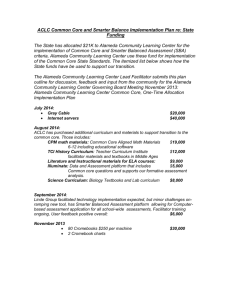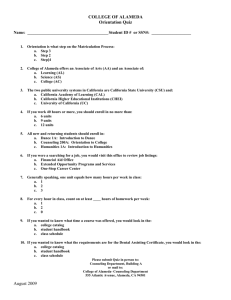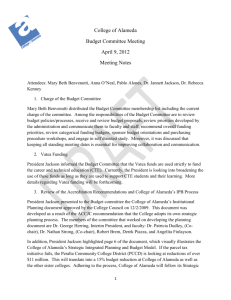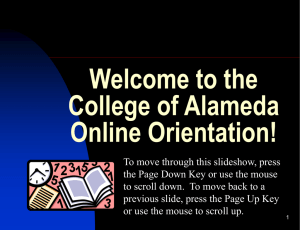Proposed - Saint Mary`s College of California
advertisement
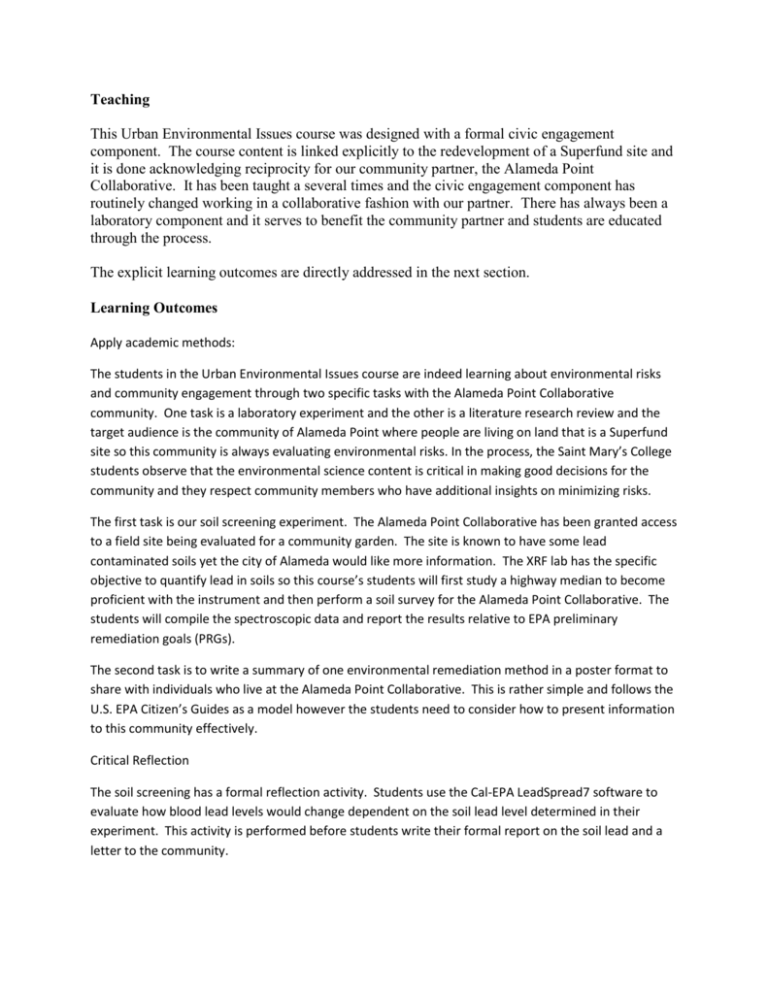
Teaching This Urban Environmental Issues course was designed with a formal civic engagement component. The course content is linked explicitly to the redevelopment of a Superfund site and it is done acknowledging reciprocity for our community partner, the Alameda Point Collaborative. It has been taught a several times and the civic engagement component has routinely changed working in a collaborative fashion with our partner. There has always been a laboratory component and it serves to benefit the community partner and students are educated through the process. The explicit learning outcomes are directly addressed in the next section. Learning Outcomes Apply academic methods: The students in the Urban Environmental Issues course are indeed learning about environmental risks and community engagement through two specific tasks with the Alameda Point Collaborative community. One task is a laboratory experiment and the other is a literature research review and the target audience is the community of Alameda Point where people are living on land that is a Superfund site so this community is always evaluating environmental risks. In the process, the Saint Mary’s College students observe that the environmental science content is critical in making good decisions for the community and they respect community members who have additional insights on minimizing risks. The first task is our soil screening experiment. The Alameda Point Collaborative has been granted access to a field site being evaluated for a community garden. The site is known to have some lead contaminated soils yet the city of Alameda would like more information. The XRF lab has the specific objective to quantify lead in soils so this course’s students will first study a highway median to become proficient with the instrument and then perform a soil survey for the Alameda Point Collaborative. The students will compile the spectroscopic data and report the results relative to EPA preliminary remediation goals (PRGs). The second task is to write a summary of one environmental remediation method in a poster format to share with individuals who live at the Alameda Point Collaborative. This is rather simple and follows the U.S. EPA Citizen’s Guides as a model however the students need to consider how to present information to this community effectively. Critical Reflection The soil screening has a formal reflection activity. Students use the Cal-EPA LeadSpread7 software to evaluate how blood lead levels would change dependent on the soil lead level determined in their experiment. This activity is performed before students write their formal report on the soil lead and a letter to the community. The literature research project will have a reflection dependent on the feedback on the poster presentation at Alameda Point Collaborative members. This presentation is typically done as a poster session and the community members ask students critical questions. If the poster session is not possible then the materials will be shared on a web resource. Regardless, students recognize that their work will be reviewed by others. Express their understanding of the interconnections Students are directed throughout the course to consider making positive contributions to society. Students are educated how this Superfund site is being cleaned up and they are taught that communities need members who will ask questions to benefit their community. The attending public meetings gives the students some idea where they might be in the future and demonstrates that community members play a specific roles. As noted above, there are reflections on meeting attendance as well as their own poster presentation, so student should observe the interconnections of their contribution and the community’s benefit. Teaching This Urban Environmental Issues course was designed with a formal civic engagement component. The course content is linked explicitly to the redevelopment of a Superfund site and it is done acknowledging reciprocity for our community partner, the Alameda Point Collaborative. It has been taught a several times and the civic engagement component has routinely changed working in a collaborative fashion with our partner. There has always been a laboratory component and it serves to benefit the community partner and students are educated through the process. The explicit learning outcomes are directly addressed in the next section. Learning Outcomes Apply academic methods: The students in the Urban Environmental Issues course are indeed learning about environmental risks and community engagement through two specific tasks with the Alameda Point Collaborative community. One task is a laboratory experiment and the other is a literature research review and the target audience is the community of Alameda Point where people are living on land that is a Superfund site so this community is always evaluating environmental risks. In the process, the Saint Mary’s College students observe that the environmental science content is critical in making good decisions for the community and they respect community members who have additional insights on minimizing risks. The first task is our soil screening experiment. The Alameda Point Collaborative has been granted access to a field site being evaluated for a community garden. The site is known to have some lead contaminated soils yet the city of Alameda would like more information. The XRF lab has the specific objective to quantify lead in soils so this course’s students will first study a highway median to become proficient with the instrument and then perform a soil survey for the Alameda Point Collaborative. The students will compile the spectroscopic data and report the results relative to EPA preliminary remediation goals (PRGs). The second task is to write a summary of one environmental remediation method in a poster format to share with individuals who live at the Alameda Point Collaborative. This is rather simple and follows the U.S. EPA Citizen’s Guides as a model however the students need to consider how to present information to this community effectively. Critical Reflection The soil screening has a formal reflection activity. Students use the Cal-EPA LeadSpread7 software to evaluate how blood lead levels would change dependent on the soil lead level determined in their experiment. This activity is performed before students write their formal report on the soil lead and a letter to the community. The literature research project will have a reflection dependent on the feedback on the poster presentation at Alameda Point Collaborative members. This presentation is typically done as a poster session and the community members ask students critical questions. If the poster session is not possible then the materials will be shared on a web resource. Regardless, students recognize that their work will be reviewed by others. Express their understanding of the interconnections Students are directed throughout the course to consider making positive contributions to society. Students are educated how this Superfund site is being cleaned up and they are taught that communities need members who will ask questions to benefit their community. The attending public meetings gives the students some idea where they might be in the future and demonstrates that community members play a specific roles. As noted above, there are reflections on meeting attendance as well as their own poster presentation, so student should observe the interconnections of their contribution and the community’s benefit. Urban Environmental Issues 2013 Course Leaning Objectives Student Learning Objectives Understand some basic concepts of 1) environmental risk assessment. 2) reaction chemistry Teaching/Learning Activities 1 ) Reading, Writing, and Discussion 2) Observe in Laboratories Student Assessment Me Exams for content; Students discuss risks in: material incorporated into Make educated decision o Understand spectroscopic method as quantification tool. Three labs utilize spectroscopy. Investigate trends in data Analysis of field sampling experiments Quantify elements or compounds and relate it to human health risks. Soil analysis and air pollutant monitoring Read Proposed Plans on pollutants Review government documents and scientific articles. Listening to different voices Critically Read Documents Synthesize information and recognize potential bias Communication skills Communication skills with respect to science improved. Increased sense of civic responsibility Improved awareness of local environmental concerns Critique EPA Videos & web resources; Create the materials for website. Writing letters to summarize soil analysis. Community experiment; respectfully attending RAB meetings or events. Review issues and learn how to find out Prepare lab reports and an Recognize the use of stan possible interferences. Students prepare lab sum provide input to letters fo Lab report and written let authorities. Assemble materials for pr Constructive participation of readings. Creating project materials incorporation into websit some perspectives. Quality of reports to class Logical construction of in letter Student self assessment o responsibility. Self assessment of studen find appropriate informat
